
Adelpha californica, the California sister, is a species of butterfly in the family Nymphalidae. They are common in California, but can also be found in western Nevada and Oregon, as well as in northern Baja California. The upper surfaces of their wings are dark brown to black with wide cream white bands dissecting both wings and two orange patches near the tips of the forewings. The underside is variously colored with browns, blue, orange, and white. A. californica is unpalatable to predators and is part of a large mimicry complex.

Crepis runcinata is a North American species of flowering plant in the family Asteraceae known by the common name fiddleleaf hawksbeard. It is native to western and central Canada, the western and central United States and northern Mexico (Chihuahua).

Choristoneura lambertiana, the sugar pine tortrix, is a moth of the family Tortricidae. It is found in the eastern parts of North America and the northern regions of the United States.
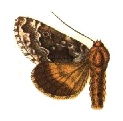
Syngrapha angulidens is a moth of the family Noctuidae first described by Smith in 1891. It is found from Alaska south in the mountains to northern Oregon, western Nevada, Arizona and New Mexico and east to Colorado, western Wyoming, Montana and Alberta.
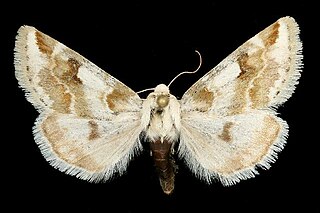
The rabbitbush flower moth is a moth of the family Noctuidae. It is found from central Arizona and New Mexico, north to Colorado, south-western Wyoming and Utah, west to Nevada and California, and north to Oregon, Idaho and Washington.
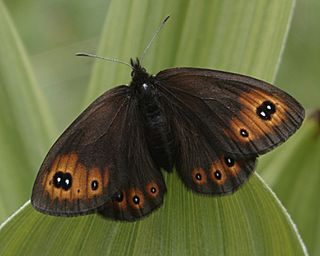
Erebia epipsodea, the common alpine, is a butterfly species of the subfamily Satyrinae of family Nymphalidae. It is found in North America from Alaska south through the Rocky Mountains to northern New Mexico and east across the prairie provinces to southwest Manitoba.

Polites sabuleti, the sandhill skipper or saltgrass skipper, is a butterfly in the family Hesperiidae. It is found from southern British Columbia and eastern Washington, south through California and northern Arizona to Baja California and east to south-eastern Wyoming, central Colorado, and north-eastern New Mexico. It is an introduced species in Hawaii.
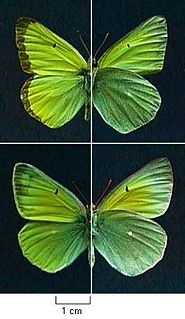
Colias alexandra, the Queen Alexandra's sulphur, Alexandra sulphur, or ultraviolet sulfur, is a butterfly in the family Pieridae found in western North America. Its range includes Alaska to the Northwest Territories and south to Arizona and New Mexico.

Colias gigantea, the giant sulphur or giant northern sulfur, is a butterfly in the family Pieridae found in North America. Its range includes Alaska across Canada to the east coast and Wyoming, Montana, and Oregon.

Chlosyne whitneyi, the rockslide checkerspot or Sierra Nevada checkerspot, is a butterfly of the family Nymphalidae. It is found in western North America from British Columbia and Alberta south, in the mountains, to California and Colorado.

Chlosyne leanira, the leanira checkerspot, is a butterfly of the family Nymphalidae. It is found in North America from western Oregon south to California, Nevada, Utah and western Colorado, as well as Baja California. The wingspan is 33–40 mm. Generally, females are larger than males, but males have a more apparent red color to their wings.

Ochlodes sylvanoides, the woodland skipper, is a butterfly of the family Hesperiidae. It is found in North America from British Columbia south to southern California, east to Montana, Colorado and Arizona.
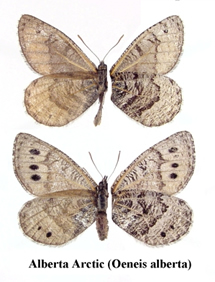
Oeneis alberta, the Alberta Arctic, is a butterfly of the family Nymphalidae. It is found from the Canadian prairie provinces east to southern Manitoba. Isolated populations are found along the Rocky Mountains in Colorado, New Mexico and Arizona.

Ethmia monticola, the gray ethmia moth, is a moth in the family Depressariidae. It is found in North America from British Columbia and Alberta to California and Arizona, east at least to North Dakota and Colorado.

The sylvan hairstreak is a butterfly of the family Lycaenidae. It is found in western North America, from British Columbia south-east to Wyoming, Colorado and New Mexico and south through California to Baja California Norte, Mexico.

Satyrium saepium, the hedgerow hairstreak, is a butterfly of the family Lycaenidae. It is found in western North America, from British Columbia south through California into Baja California and east through northern Arizona to northern New Mexico, Colorado and Montana.

Oeneis uhleri, or Uhler's Arctic, is a species of butterfly in the family Nymphalidae.
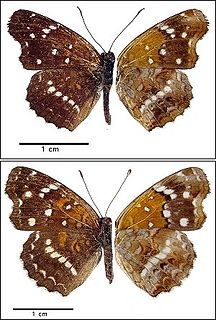
Anthanassa texana, the Texan crescentspot, is a species of butterfly in the family Nymphalidae. It is found from Guatemala north through Mexico to southern California, east across the southern United States to northern Florida, Georgia and South Carolina. Strays may be found up to Arkansas, Missouri, Illinois, South Dakota, and central Nevada. The habitat consists of deserts, dry gulches, open areas, streamsides, road edges, and city parks.
Living Legends, originally the Lamanite Generation, is a song and dance performing group at Brigham Young University made up of performers of Native American, Polynesian and Hispanic or Latino origin. They perform dances that originate in these cultures as well. Living Legends was formed in 1971 by Janie Thompson.

Speyeria egleis, commonly known as the Great Basin fritillary or egleis fritillary, is a butterfly of the family Nymphalidae. It is found in North America, where it has been recorded from North Dakota southwest through Oregon to California and south to Colorado. The habitat consists of mountain meadows, forest openings and exposed rocky ridges.



















